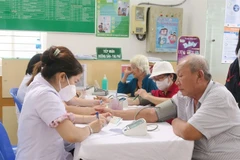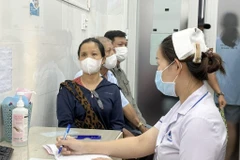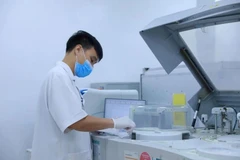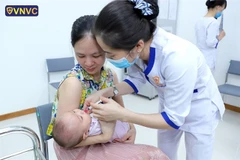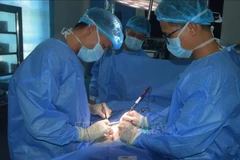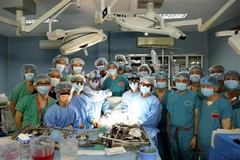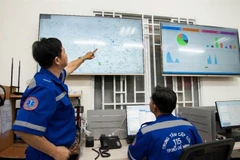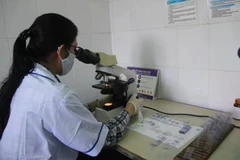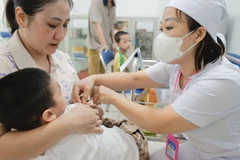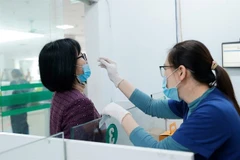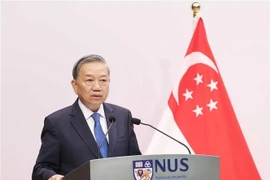Q: Will you please explain the supply mechanism for privately paid vaccines in our country at present?
Thesupply operates according to market demand between customers andsuppliers. Meanwhile, under our national expanded immunisationprogramme, the Government has to ensure a sufficient supply of vaccinesto all children under five years free of charge. Under Vietnamese Law,all children under five have to be immunised.
At present, many ofthese vaccines, particularly the six-in-one (a combination of sixdifferent vaccines for diphtheria, tetanus, whooping cough, hepatitis B,polio and Haemophilus influenza type B) are in short supply.
However,under the expanded Government programme, we have Quinvaxem vaccine – afive in one vaccine having the same quality as the five-in-one Pentaximvaccine or six-in-one Infranrix hexa vaccine to protect againstdiphtheria, tetanus, whooping cough, hepatitis B and Haemophilusinfluenza Type B.
I have to concede some of the vaccinesavailable on the privately paid list are not provided under the NationalExpanded Immunisation Programme. They include those that protectagainst chicken pox, mumps and rabies.
Q: In your opinion, what are the main causes for the scarcity in the supply of vaccines?
Thereare various factors leading to the shortage of the five-in-one andsix-in-one vaccines. However, in my opinion, the two main ones are thatmakers modified their production chains, leading to a slowdown inproduction.
Based on the information we have the supplies ofvaccines for rabies and chicken pox in Vietnam in 2015 will be same asthose in 2014. But for the six-in-one vaccine (Infranrix hexa vaccine), atotal of only 30,000 doses will be available – about one tenth of thedoses provided in 2104.
The same situation is expected with thefive-in-one vaccine (Pentaxim vaccine). All in all, in 2015, foreignsuppliers will be able to provide Vietnam with 300,000 doses of theInfranrix hexa and the Pentexim vaccines. Meanwhile, each child needsinoculations at the age of two, three and four months. This means, these300,000 doses will only be able to protect 100,000 children.
Q: How many Vietnamese children must receive vaccinations against common diseases in a year?
Vietnamnow has 1.6 million newborn babies a year while the coverage of thenational expanded immunisation programme is more than 95 percent ofchildren. This means that between 4.5-4.8 million children must bevaccinated against diphtheria, whooping cough and tetanus. And each ofthem must have three shots for each disease.
So, under thenational expanded immunisation programme, 1.6 million children will beinoculated while in the privately paid services, just about 100,000children will be vaccinated.
Basically speaking, all childrenunder five years old in Vietnam are covered by the national immunisationprogramme, including the inoculation of the five in one Quinvaxemvaccine. However, the vaccine services are only available in majorcities such as Hanoi, Ho Chi Minh City and Da Nang. This is a key factorleading to the long queues to buy vaccines by parents.
Q: Someparents think the quality of vaccine services is better than those inthe national immunisation programme. How do you respond to that?
Ijust want to emphasise there is no difference in quality betweenvaccines provided in the national vaccination programme and those in thepaid services.
All vaccines used in the national vaccinationprogramme are special vaccines which have been checked and approved bythe World Health Organisation and Vietnamese functional agencies.
Morerecently, some children were reported to have whooping cough as theydidn't have their vaccination shots against the cough. This is aneloquent proof showing that the quality of vaccines provided in thenational programme is as good as those of privately paid vaccines.
Q: Does the Ministry of Health have any plan to solve the problem of "severe shortage" of paid vaccines this year?
Atthe start of the year, the Ministry of Health requested vaccinemanufacturers to make public the volume of vaccines they could supply toVietnam in 2015. Following the request, they informed us that theycould only supply vaccines of the six-in-one and five-in-one for 100,000of 1.6 million Vietnamese children.
In addition, the Ministry ofHealth has also asked the paid services units to replace the shortageof paid vaccines with similar vaccines available in the NationalImmunisation Programme to give to the children without any surcharge.The ministry's decision is to protect the under-five-year-old children'srights.-VNA
